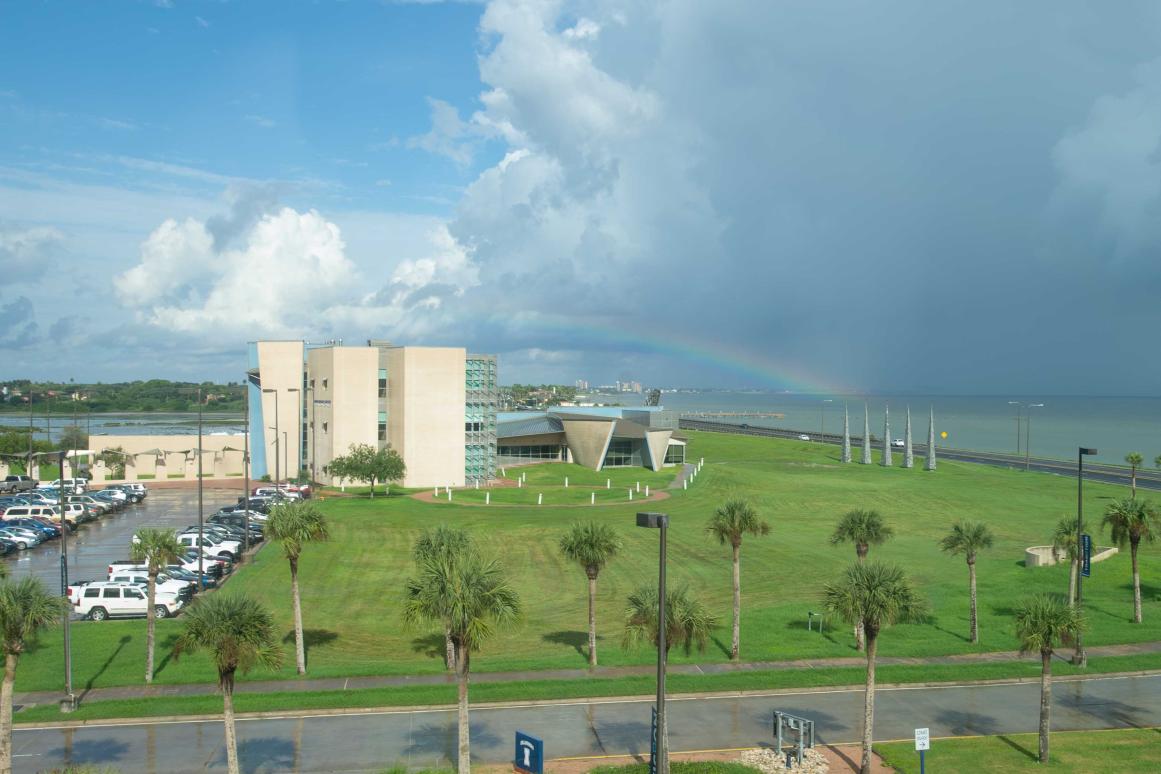Ripple Effect: Advancing the Missions of HRI and TAMU-CC Together

This is the first in a series of stories looking at the history and impact of HRI over the last 25 years.
On a summer morning, a Texas A&M University-Corpus Christi (TAMU-CC) student wades knee deep into the warm waters of the Gulf, sampling equipment in hand. Next to them, a scientist from the University’s Harte Research Institute (HRI) explains how their program to recycle oyster shells created new reefs which restore marine habitats and protect coastline. One hundred miles offshore in the Gulf, another student is working alongside HRI experts tagging mako sharks to help craft solutions for fisheries management.
This is HRI at TAMU-CC today — where classrooms extend far beyond four walls and where research isn’t confined to labs but thrives in the field, in the community, and on the frontlines of conservation. The establishment of HRI in 2000 thanks to Ed Harte’s $46 million gift wasn’t just the launch of a research institute, it was a transformation. It redefined what it meant to learn, to discover, and to make an impact.
HRI’s cutting-edge research, focusing on the Gulf’s ecosystems, economies, and policies quickly became one pillar of the university’s broad identity. As HRI flourished, so did TAMU-CC’s reputation as a research powerhouse.
"I have had the privilege of watching the impact this gift has had on our campus over the last 25 years,” said TAMU-CC President Dr. Kelly M. Miller. “Not only did the gift allow our coastal and marine sciences programs to earn an international reputation for excellence, but it affected the entire university. We became a university focused on how we could have broader, global impacts."
TAMU-CC provides the fertile ground HRI needs to grow — and an academic home where research is shaped by the next generation of marine scientists. But the students aren’t just learning from textbooks; they are taking trips on Baffin Bay to help collect water quality samples, diving to monitor coral reef growth at the Flower Garden Banks National Marine Sanctuary and traveling internationally to tackle global environmental issues.
“HRI offers students with invaluable and unique hands-on opportunities that significantly enhance their education and compliment what they learn in the classroom,” said Dr. Ahmed Mahdy, TAMU-CC’s Executive Vice President for Research and Innovation. “Not only that, HRI’s fellowships and scholarships remove financial barriers so students can pursue advanced degrees. Additionally, students benefit from being mentored and trained by world class faculty and researchers. This creates an incredible ability to build strong work ethics for students and a great sense of pride in the research that we do.”
The university — founded in 1947 — became part of the Texas A&M University system in 1989 and changed its name to Texas A&M University-Corpus Christi in 1993. In 1994, it began offering four-year degree plans, marking the start of its ascent to top-tier research university status. Its location on an island along the Gulf provided a unique opportunity to create programs of local and worldwide interest.
HRI has grown into a world-renowned marine research institute that features dozens of research scientists, multiple endowed chairs, cutting-edge laboratories, and programs that have helped shape policy on the Texas coast.

The vision behind HRI blends a deep commitment to coast and marine sustainability with a focus on interdisciplinary collaboration and community engagement — principles that continue to shape its success today. As HRI grows, it remains uniquely positioned as a marine research institute embedded within a vibrant university campus, where science intersects with a range of academic disciplines.
Meanwhile, TAMU-CC is evolving alongside HRI, strengthening its reputation as a leading research university for not just marine science but also Unmanned Aircraft Systems (UAS), nursing, and education.
As an integral part of TAMU-CC, HRI serves as a model for how a marine research institute can thrive within a university, blending scientific inquiry with academic excellence. This dynamic synergy drives growth for the institute and university.
“If you look at other institutions that have research activities going on, they’ve been developed over a period of 50 or 100 years,” said Dr. Robert Furgason, former TAMU-CC President and HRI Executive Director. “Our institute has made a dramatic impact on the Gulf in 25 years. You can never be certain how a seed will grow, but this one has truly flourished. It’s something the entire university community can look back on with pride and say, ‘We were a part of that.’”
